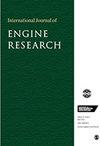利用能源和排放管理监督战略,优化零排放区附近插电式混合动力电动汽车的成本-排放权衡
IF 2.1
4区 工程技术
Q2 ENGINEERING, MECHANICAL
引用次数: 0
摘要
无污染环境的呼声日益高涨,促使世界各地纷纷建立零排放区(ZEZ)。对于地区和国家交通而言,插电式混合动力电动汽车(PHEV)是一种极具吸引力的选择,它也能实现零排放驾驶。为了应对 PHEV 在实现足够的零排放行驶里程和满足零排放区外实际排放目标方面的挑战,本研究提出了一种自适应监管控制策略,在遵守尾气[公式:见正文]排放限制的同时,最大限度地降低总运营成本。它将模块化能源管理策略(MEMS)与综合排放管理策略(IEM)相结合,前者用于实现成本最优的功率分配,后者用于确定成本最优的内燃机气路设置。根据庞特里亚金最小原理,推导出一种可实时实施的最优控制策略。为了确定该策略中使用的共态的最佳选择,针对不同的路线段和实际周期进行了数值优化。这项研究表明,PHEV 可以成功地在 ZEZ 附近运行。与采用固定共态的标准策略相比,在所研究的真实世界循环中,该建议策略能够实现成本和[公式:见正文]排放量的降低,分别高达 10%和 22%。本文章由计算机程序翻译,如有差异,请以英文原文为准。
Optimal cost-emission trade-off for plug-in hybrid electric vehicles around zero emission zones using a supervisory energy and emissions management strategy
The growing call for pollution-free environments has prompted the creation of zero-emission zones (ZEZs) around the world. For regional and national transport, plug-in hybrid electric vehicle (PHEV) are an attractive option, which also offer ZE driving. To address the PHEV challenges of sufficient ZE driving range and of meeting real-world emission targets outside the ZEZs, this work proposes an adaptive supervisory control strategy, which minimizes the total operational costs while complying with tailpipe [Formula: see text] emissions constraints. It combines a Modular Energy Management Strategy (MEMS), for cost-optimal power-split, with an Integrated Emission Management (IEM) strategy for determining the cost-optimal air path setting of the internal combustion engine. A real-time implementable, optimal control strategy is derived based on Pontryagin’s Minimum Principle. To determine the optimal selection of the co-states used in this strategy, a numerical optimization is performed for different route segments and real-world cycles. This study demonstrates that PHEVs can successfully be operated around ZEZs. The best performance is realized with an adaptive supervisory control strategy with different co-states per route segment; compared to the standard strategy with fixed co-states, this proposed strategy was able to achieve cost and [Formula: see text] emission reductions of up to 10% and 22%, respectively, for the studied real-world cycles.
求助全文
通过发布文献求助,成功后即可免费获取论文全文。
去求助
来源期刊

International Journal of Engine Research
工程技术-工程:机械
CiteScore
6.50
自引率
16.00%
发文量
130
审稿时长
>12 weeks
期刊介绍:
The International Journal of Engine Research publishes high quality papers on experimental and analytical studies of engine technology.
 求助内容:
求助内容: 应助结果提醒方式:
应助结果提醒方式:


